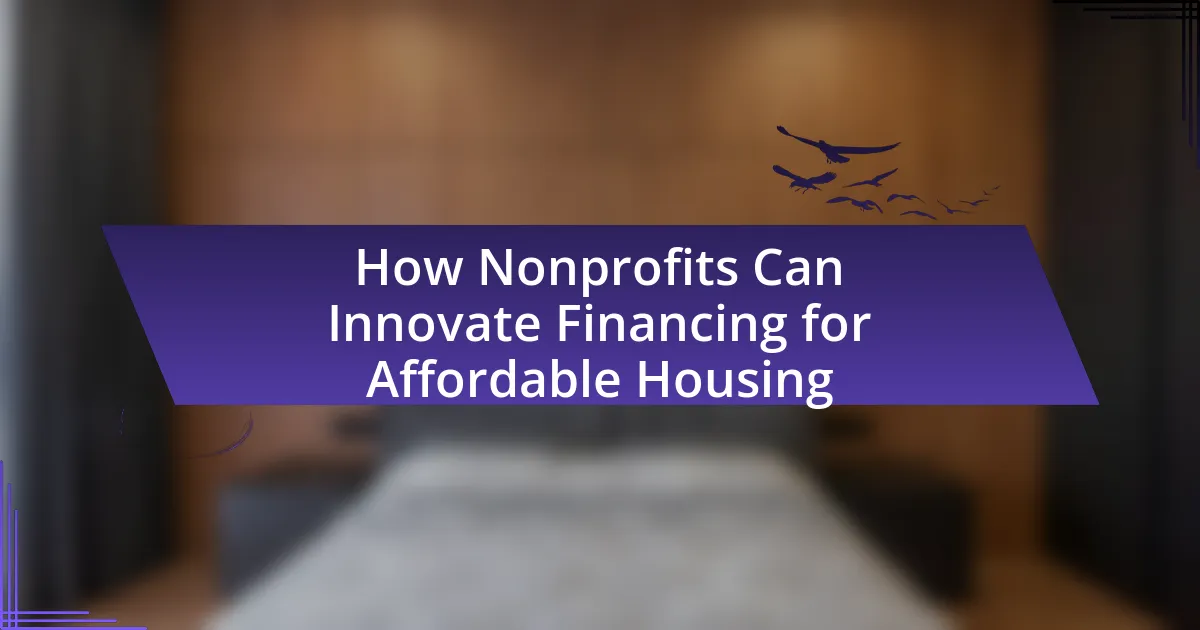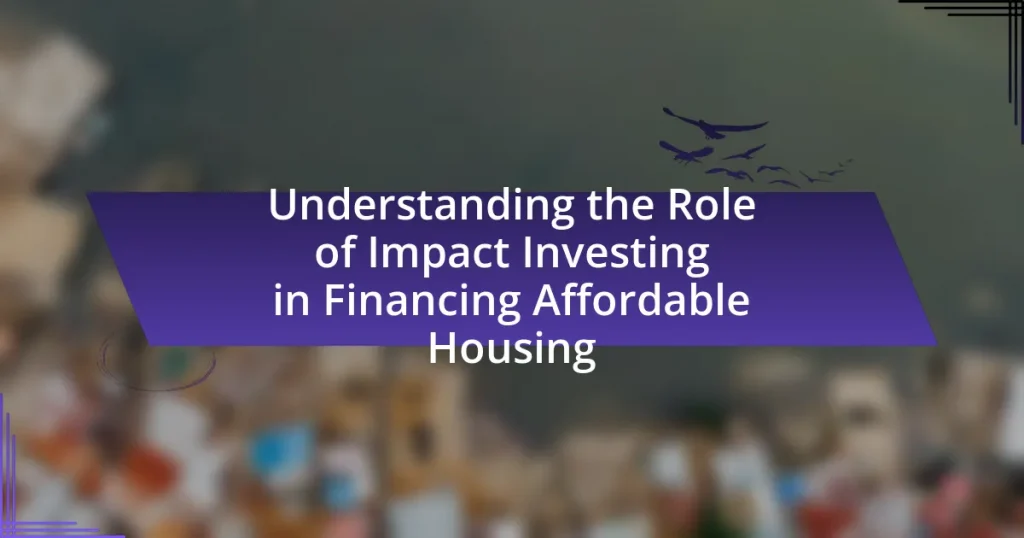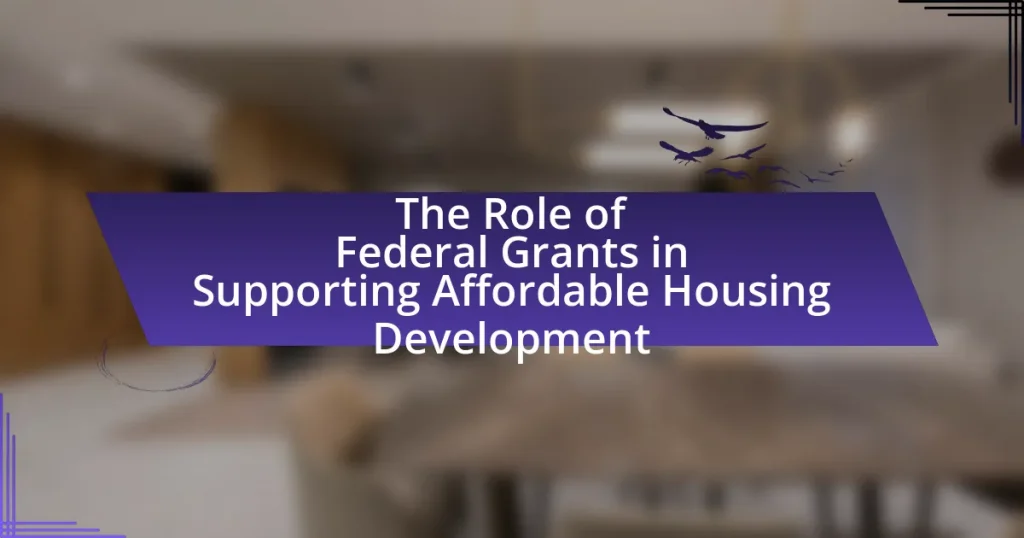The article focuses on how nonprofits can innovate financing for affordable housing, addressing the current challenges in securing funding, such as limited access to capital, rising construction costs, and regulatory barriers. It highlights the shortcomings of traditional financing methods for nonprofits, including stringent eligibility criteria and the need for collateral. The article emphasizes the importance of innovative financing strategies, such as social impact bonds and public-private partnerships, to enhance housing accessibility and sustainability. Additionally, it outlines best practices for nonprofits to adopt these strategies effectively, measure their success, and avoid common pitfalls in financing affordable housing initiatives.

What are the current challenges in financing affordable housing?
The current challenges in financing affordable housing include limited access to capital, rising construction costs, and regulatory barriers. Limited access to capital arises from traditional lenders’ reluctance to finance projects perceived as high-risk, which often leads to insufficient funding for affordable housing initiatives. Rising construction costs, driven by inflation and supply chain disruptions, further strain budgets, making it difficult to maintain affordability. Regulatory barriers, such as zoning restrictions and lengthy approval processes, can delay projects and increase costs, ultimately hindering the development of affordable housing. These factors collectively create a challenging environment for financing affordable housing solutions.
How do traditional financing methods fall short for nonprofits?
Traditional financing methods fall short for nonprofits primarily due to their reliance on collateral and creditworthiness, which many nonprofits lack. Nonprofits often operate with limited assets and inconsistent revenue streams, making it difficult to secure loans or traditional funding. According to the National Council of Nonprofits, over 60% of nonprofits report that access to capital is a significant barrier to their operations. Additionally, traditional financing typically involves lengthy approval processes and stringent requirements that do not align with the urgent needs of nonprofits, particularly in sectors like affordable housing where timely funding is crucial.
What limitations do nonprofits face in accessing conventional funding?
Nonprofits face several limitations in accessing conventional funding, primarily due to stringent eligibility criteria and a lack of collateral. Many traditional funding sources, such as banks and government grants, require nonprofits to demonstrate financial stability and a proven track record, which can be challenging for newer or smaller organizations. Additionally, nonprofits often struggle to provide the necessary collateral that conventional lenders demand, as they typically operate with limited assets. According to a report by the National Council of Nonprofits, 60% of nonprofits cite funding constraints as a significant barrier to their operations, highlighting the systemic challenges they encounter in securing conventional financial support.
How do market fluctuations impact affordable housing financing?
Market fluctuations significantly impact affordable housing financing by altering interest rates, property values, and funding availability. When the economy experiences downturns, interest rates typically decrease, which can lower borrowing costs for affordable housing projects. However, during economic booms, rising property values can lead to increased costs for land and construction, making it more challenging to finance affordable housing. Additionally, fluctuations can affect government funding and grants, as budget constraints during economic downturns may reduce available resources for affordable housing initiatives. For instance, the National Low Income Housing Coalition reported that during the 2008 financial crisis, funding for affordable housing programs was severely impacted, highlighting the direct correlation between market conditions and financing availability.
Why is innovation necessary in financing affordable housing?
Innovation is necessary in financing affordable housing to address the growing gap between housing demand and supply, which has reached crisis levels in many urban areas. Traditional financing methods often fail to meet the unique needs of low-income populations, leading to insufficient housing options. For instance, according to the National Low Income Housing Coalition, there is a shortage of 7 million affordable rental homes for extremely low-income renters in the United States. Innovative financing solutions, such as social impact bonds and community land trusts, can mobilize new capital sources and create sustainable funding mechanisms. These approaches not only enhance affordability but also promote long-term community stability and resilience, making them essential for effective affordable housing strategies.
What are the consequences of stagnant financing models?
Stagnant financing models lead to reduced investment in affordable housing, resulting in a shortage of available units. This lack of funding limits the ability of nonprofits to develop new projects, maintain existing properties, and respond to community needs. According to the National Low Income Housing Coalition, the U.S. faces a shortage of 7 million affordable rental homes for extremely low-income renters, highlighting the critical impact of inadequate financing. Additionally, stagnant models can perpetuate socioeconomic disparities, as marginalized communities remain underserved and unable to access safe and affordable housing options.
How can innovative financing improve housing accessibility?
Innovative financing can improve housing accessibility by providing flexible funding solutions that lower barriers to homeownership and rental opportunities. For instance, models such as social impact bonds and community land trusts enable nonprofits to leverage private investment for affordable housing projects, thereby increasing the availability of low-cost housing options. According to a report by the Urban Institute, innovative financing mechanisms can mobilize up to $1.5 trillion in private capital for affordable housing, significantly enhancing access for low-income families. This approach not only diversifies funding sources but also fosters collaboration between public and private sectors, ultimately leading to more sustainable housing solutions.

What innovative financing strategies can nonprofits adopt?
Nonprofits can adopt innovative financing strategies such as social impact bonds, which allow them to raise capital from private investors to fund social programs, with returns tied to the achievement of specific outcomes. This approach has been successfully implemented in various sectors, including affordable housing, where organizations like the Massachusetts Housing Investment Corporation have utilized these bonds to finance housing projects that meet measurable social goals. Additionally, nonprofits can explore crowdfunding platforms to engage community members in funding initiatives, as seen in projects like the “Home for Good” campaign, which raised significant funds for housing solutions through small individual contributions. These strategies not only diversify funding sources but also align financial incentives with social impact, enhancing the sustainability of affordable housing initiatives.
How can nonprofits leverage social impact bonds for housing projects?
Nonprofits can leverage social impact bonds (SIBs) for housing projects by securing upfront capital from private investors to fund initiatives aimed at improving housing stability and reducing homelessness. This financing model allows nonprofits to implement evidence-based programs, such as supportive housing or rental assistance, with the promise of repayment contingent on achieving specific social outcomes, like reduced emergency room visits or lower rates of eviction. For instance, the Social Impact Partnership Act of 2018 in the United States encourages the use of SIBs to address social issues, including affordable housing, by allowing states to enter into agreements that fund programs based on their success in achieving measurable results. This approach not only attracts private investment but also aligns the interests of investors, nonprofits, and government entities towards shared social goals.
What are the key components of social impact bonds?
The key components of social impact bonds include a contractual agreement between public sector entities, private investors, and service providers, where funding is contingent on achieving specific social outcomes. These bonds typically involve measurable performance metrics, which are used to assess the success of the interventions funded by the investors. Additionally, the public sector agrees to repay the investors with a return on investment if the predetermined outcomes are met, thus aligning financial incentives with social objectives. This structure has been utilized in various sectors, including education and healthcare, to drive innovation and efficiency in addressing social issues.
How do social impact bonds align with nonprofit missions?
Social impact bonds align with nonprofit missions by providing a funding mechanism that incentivizes measurable social outcomes, which is often a core objective of nonprofits. These bonds allow nonprofits to secure upfront capital for programs aimed at addressing social issues, such as affordable housing, while shifting the financial risk to private investors. For instance, if a nonprofit successfully reduces homelessness through a housing initiative, the government repays investors based on the achieved outcomes, thus reinforcing the nonprofit’s mission to create social impact. This alignment is evident in programs like the Social Impact Bond in New York City, which focuses on reducing recidivism rates, demonstrating how financial structures can directly support nonprofit goals.
What role do public-private partnerships play in financing?
Public-private partnerships (PPPs) play a crucial role in financing by leveraging resources and expertise from both sectors to fund projects that may not be feasible through public or private funding alone. These collaborations enable the sharing of risks and costs, which can lead to more efficient project delivery and innovation in financing mechanisms. For instance, in affordable housing initiatives, PPPs can combine government incentives with private investment to create sustainable funding models, as evidenced by successful projects in cities like New York and San Francisco, where such partnerships have led to the development of thousands of affordable housing units.
How can nonprofits effectively collaborate with private entities?
Nonprofits can effectively collaborate with private entities by establishing clear mutual goals and leveraging each other’s strengths. This collaboration often involves forming partnerships where nonprofits provide community insights and outreach capabilities, while private entities contribute financial resources and expertise in project management. For instance, a study by the Urban Institute highlights successful collaborations in affordable housing projects, demonstrating that joint ventures can lead to increased funding and improved project outcomes. By aligning their missions and sharing resources, nonprofits and private entities can create sustainable solutions for affordable housing challenges.
What are the benefits of public-private partnerships for affordable housing?
Public-private partnerships (PPPs) for affordable housing provide several key benefits, including increased funding, shared risk, and enhanced efficiency in project delivery. These partnerships leverage public resources and private sector expertise, resulting in a more comprehensive approach to addressing housing shortages. For instance, a study by the Urban Institute found that PPPs can reduce project costs by up to 20% through streamlined processes and innovative financing solutions. Additionally, PPPs often lead to faster project completion times, as private entities can mobilize resources and expertise more rapidly than public agencies alone. This collaborative model not only expands the availability of affordable housing but also fosters community engagement and investment, ultimately contributing to sustainable urban development.

How can nonprofits implement these innovative financing methods?
Nonprofits can implement innovative financing methods by establishing partnerships with private investors and leveraging social impact bonds. These strategies enable nonprofits to attract capital for affordable housing projects while aligning financial returns with social outcomes. For instance, social impact bonds allow nonprofits to receive upfront funding from investors, which is repaid based on the achievement of specific social metrics, thus incentivizing effective project execution. Additionally, nonprofits can utilize crowdfunding platforms to engage community members and raise funds directly for housing initiatives, tapping into local support and resources.
What steps should nonprofits take to adopt new financing strategies?
Nonprofits should conduct a comprehensive assessment of their current financial landscape to adopt new financing strategies. This involves analyzing existing funding sources, identifying gaps, and understanding the financial needs of their programs. Following this assessment, nonprofits should explore diverse financing options such as social impact bonds, crowdfunding, and partnerships with private investors, which have been shown to enhance funding opportunities. Additionally, nonprofits should engage in capacity building by training staff on financial management and innovative financing models, as evidenced by successful case studies in the sector. Finally, establishing strong relationships with stakeholders, including government agencies and community organizations, can facilitate access to new funding sources and collaborative financing initiatives.
How can nonprofits assess their readiness for innovative financing?
Nonprofits can assess their readiness for innovative financing by evaluating their organizational capacity, financial health, and strategic alignment with innovative funding models. This assessment involves analyzing existing financial statements, understanding cash flow dynamics, and identifying potential revenue streams that align with innovative financing options such as social impact bonds or pay-for-success models. Research indicates that organizations with strong financial management practices and a clear mission are more likely to successfully engage in innovative financing, as evidenced by a study from the Nonprofit Finance Fund, which found that 70% of nonprofits that assessed their financial readiness reported improved access to capital.
What resources are available to support nonprofits in this transition?
Nonprofits can access various resources to support their transition in innovating financing for affordable housing. Key resources include grants from foundations such as the Ford Foundation, which focuses on social justice and affordable housing initiatives, and government programs like the Community Development Block Grant (CDBG) program, which provides federal funds to support community development projects. Additionally, organizations like the National Council of Nonprofits offer guidance and tools for financial management and fundraising strategies tailored to the nonprofit sector. These resources are essential for nonprofits to effectively navigate the complexities of financing affordable housing projects.
What best practices should nonprofits follow when innovating financing?
Nonprofits should adopt a diversified funding strategy when innovating financing, as this approach mitigates risk and enhances financial stability. By leveraging multiple sources such as grants, social impact investments, and crowdfunding, nonprofits can create a robust financial foundation. For instance, a study by the Nonprofit Finance Fund in 2020 highlighted that organizations with diverse funding streams reported greater resilience during economic downturns. Additionally, nonprofits should engage in partnerships with private sector entities to access innovative financing mechanisms, such as social impact bonds, which have been shown to effectively fund affordable housing projects. This collaborative approach not only broadens funding opportunities but also aligns the interests of various stakeholders, fostering a sustainable financial ecosystem for affordable housing initiatives.
How can nonprofits measure the success of their financing innovations?
Nonprofits can measure the success of their financing innovations by evaluating key performance indicators (KPIs) such as the amount of capital raised, the number of projects funded, and the impact on affordable housing availability. For instance, a nonprofit that implements a new financing model can track the total funds generated through that model and compare it to previous fundraising efforts, demonstrating increased financial efficiency. Additionally, measuring the number of housing units created or preserved as a direct result of these innovations provides concrete evidence of their effectiveness. Research from the Urban Institute indicates that innovative financing strategies can lead to a 20% increase in affordable housing projects, underscoring the importance of these metrics in assessing success.
What common pitfalls should nonprofits avoid in financing affordable housing?
Nonprofits should avoid underestimating project costs when financing affordable housing. Accurate budgeting is crucial, as many projects fail due to unforeseen expenses that exceed initial estimates. For instance, a study by the Urban Institute found that cost overruns can lead to project delays and funding shortfalls, ultimately jeopardizing the availability of affordable units. Additionally, nonprofits must steer clear of relying solely on a single funding source, as diversification of funding streams enhances financial stability and reduces risk. According to the National Low Income Housing Coalition, projects that utilize multiple funding sources are more likely to succeed and sustain long-term affordability. Lastly, nonprofits should not overlook the importance of community engagement; failing to involve local stakeholders can result in projects that do not meet community needs, leading to resistance and potential project failure.
What practical tips can nonprofits use to enhance their financing efforts?
Nonprofits can enhance their financing efforts by diversifying funding sources, which includes seeking grants, individual donations, corporate sponsorships, and social impact investments. Diversification reduces reliance on a single funding stream and increases financial stability. For instance, according to the National Council of Nonprofits, organizations that engage in multiple fundraising strategies are more likely to achieve their financial goals and sustain their operations over time. Additionally, nonprofits should leverage technology for online fundraising campaigns, as platforms like crowdfunding have shown to increase donor engagement and contributions significantly. A report by the Nonprofit Finance Fund indicates that nonprofits utilizing digital tools for fundraising saw a 30% increase in donations compared to those relying solely on traditional methods.



